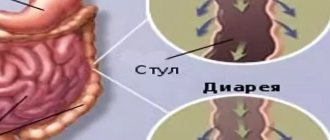Why does yellow diarrhea occur in an adult, what diseases can cause such a symptom and what can be done to stop it?
It is probably surprising for many that an experienced doctor, even by the color of the stool, will be able to determine what disease is bothering his patient and prescribe the necessary treatment. Today we will reveal to you some secrets of professionals and tell you what yellow diarrhea means in an adult, what diseases it can tell us about and, most importantly, how to get rid of it.
What to do if an adult has diarrhea, the causes and treatment of this disease can be found out by reading our other article on this site.
Factors causing yellow diarrhea
The act of defecation should occur every day, once or twice. Any deviations require special attention, often even treatment. Bile secreted by the gallbladder is involved in the formation of excrement. It is this that gives the brown color to feces, more precisely the pigment bilirubin, which is one of the components of bile. When bile is not produced in sufficient quantities, the stool is not completely saturated with pigment, and as a result we have yellow excrement.
This also happens when stool is passed out of the intestines too quickly, without having time to color and thicken. As a result, it becomes liquid like water. Common causes of yellow diarrhea include:
- infectious diseases,
- dysbacteriosis,
- intoxication,
- gastrointestinal diseases,
- taking antibacterial drugs for a long time,
- stress,
- menopause,
- influence of alcohol,
- hormonal disorders,
- helminthiases.
Diarrhea often occurs due to climate change, diet, and stress.
This is a manifestation of the body’s adaptation to any changes; such conditions do not require special treatment. But do not forget about the dangerous causes of diarrhea. The main factors that provoke loose yellow stools are: inflammation in the intestines, dysbacteriosis, pancreatitis. When yellow, loose stool appears in an adult, it is necessary to determine whether there are any other complaints or signs of disruption of the body. Diarrhea is not an independent disease; it is just one of the symptoms indicating problems in the body. Elimination of diarrhea should begin with the treatment of the disease that caused it.
Prevention of diarrhea
In order for the body to fully recover, it is necessary to maintain proper nutrition. To maintain water balance, you should drink intensively for 14 days. To prevent diarrhea, it is recommended to maintain good personal hygiene. If a person has previously suffered from diarrhea, then probiotics are taken as a preventive measure. It is recommended to drink a decoction of St. John's wort or herbal tea.
Depending on the signs and changes in stool color, a person should pay close attention to their health. Stool mixed with secretions that were previously unnoticed can become a symptom of a serious illness. In most cases, the problem is considered to be yellow diarrhea with possible variations. A person needs to pay attention to additional symptoms. Sometimes this refers to the manifestation of adaptation of the body.
https://youtu.be/JJDtfpIJ_ro
We recommend: Why does a newborn have fever and diarrhea and how to alleviate the baby’s condition?
Diseases associated with infection
Yellow diarrhea can occur with dysentery, an infectious disease caused by the dysentery bacillus. Associated symptoms in an adult: severe abdominal pain, increased body temperature, unformed feces, frequent watery diarrhea with mucus. With this disease, there is an increase in bowel movements up to ten times per day.
With rotavirus infection, loose yellow stool occurs, mainly in the first days of the disease, then it becomes yellow-green, then gray-yellow.
Salmonellosis in adults is also characterized by the presence of yellow stool, liquid like water, with mucus, and foamy diarrhea is not excluded.
Staphylococcal infection: watery diarrhea is observed, foamy stool is yellow-green in color, and has an unpleasant odor.
Diseases of the gastrointestinal tract
Diseases of the stomach, liver, pancreas, intestines or gall bladder also cause yellow diarrhea.
A clear sign of such diseases is a yellow coating on the tongue. The thinner and lighter it is, the earlier the disease is. Pancreatitis is a disease of the pancreas. Characteristic symptoms: yellow mushy diarrhea, belching, constant nausea, vomiting after eating, weakness, weight loss. The pain syndrome is pronounced, patients complain that their stomach hurts after every meal, the pain sometimes takes on a girdling character. The act of defecation occurs three times a day or more. Undigested food remains are often observed in the stool.
Gastritis is inflammation of the gastric mucosa. With this disease, an adult has a yellow tongue, a very sore stomach, nausea in the morning, and sometimes severe diarrhea.
Hepatitis is inflammation of the liver. A yellow coating also appears on the tongue. Characteristic changes in feces:
- diarrhea with foam in an adult,
- stool with a yellowish tint,
- stinking putrid odor of feces.
Among other diseases that can contribute to the appearance of yellow feces and diarrhea with mucus in an adult are peptic ulcers and cholelithiasis.
What does it mean
Most often, food stains stool. For example, if you drink a lot of milk, the color of the stool will become lighter; fatty foods have a similar effect on the color. If the stool has become lighter in color, then you should remember what you ate in the last few days and reduce or remove this food from your diet.
Light brown or light yellow
Most likely, plant foods predominate in the diet. This is not harmful to health, but to normalize stool, include more protein foods in your diet and eat small portions more often.
Very light
If such feces appear once or during the day, then do not worry. But if the color persists for a long time, then problems with the pancreas are possible.
Beige
If the stool is beige in color, there may be a problem with the liver or bile ducts.
Effect of drugs on stool changes
Yellow diarrhea in adults often occurs when taking multivitamin complexes. Taking antibacterial drugs for a long time causes dysbiosis, which is also characterized by the appearance of a yellow coating on the tongue and seething in the stomach.
Causes of diarrhea that do not require drug treatment: overeating, stress, climate change.
If diarrhea occurs under the influence of these factors, you should reduce the consumption of foods that increase intestinal motility and fermentation processes. These are cabbage, onions, radishes, milk, greens. You need to eat enough lean meat, fresh cottage cheese and cereals. When the cause of diarrhea is eliminated and with proper nutrition, bowel movements return to normal within a few days. Diarrhea may also occur after drinking alcohol. Alcohol thus removes fluid from the body.
Causes
Diarrhea is not a disease, but a symptom that appears as an expression of numerous diseases and conditions. Basic list of diseases, medications and conditions that cause diarrhea:
- Infectious pathogens: common viruses (norovirus, rotavirus, adenovirus), bacteria (Campylobacter, salmonellosis, cholera, listeria, E. coli, clostridia, typhoid fever), rare fungi and parasites (protozoa, such as Giardia, dysenteric amoeba, cryptosporidium),
- Sweeteners,
- Traveler's diarrhea (usually Escherichia coli),
- Domperidone, metoclopramide, NSAIDs, orlistat, magnesium, cytostatics, iron, laxatives and antibiotics,
- Poisoning,
- Heavy metals,
- Stress, nervousness,
- Food allergies and intolerances,
- Irritable bowel syndrome,
- Inflammatory bowel diseases,
- Tumors,
- Lactose intolerance and other metabolic disorders.
Diagnostics
In order to determine the true cause of yellow or green diarrhea in an adult, the following research methods must be used:
- General blood analysis. A high level of ESR and leukocytosis are determined, this indicates the presence of an inflammatory process in the body.
- Blood chemistry. High alpha-amylase levels indicate chronic pancreatitis.
- Coprogram - microscopic analysis of stool. The presence of muscle fibers in feces also indicates chronic pancreatitis. Detection of a large number of leukocytes – inflammation in the intestines. Colitis may be the cause of the presence of red blood cells.
- Bacteriological culture of stool. Thanks to this research method, it is possible to detect the causative agent of an infectious disease.
After these tests, the doctor may need additional research methods, such as: ultrasound of the abdominal organs, radiography, endoscopy.
Associated symptoms
Depending on the underlying disease that caused the syndrome, yellow liquid stool is accompanied by other symptoms:
- heat;
- headache;
- discomfort and pain in the central abdominal area;
- muscle weakness;
- inexplicable feeling of thirst;
- lack of appetite;
- increased sweating;
- vomit;
- nausea;
- feeling of fermentation.
The presence of several of the listed symptoms provides a serious reason for increased vigilance. To understand when you need to see a doctor, it is important to monitor your condition and make an appointment as soon as possible if:
- The stool does not return to normal for a long time. If for a week or more the patient cannot cope with the syndrome with proper nutrition, and medications provide only a short-term effect, consultation with a qualified medical professional is required. In such cases, as a rule, the cause of liquid yellow stool lies in more serious diseases of the internal organs, and therefore, thorough therapy will be required.
- The feces have changed consistency and color. An immediate visit to the doctor requires a change in the color of the stool - if it becomes black or blood-red for no apparent reason (after, for example, taking activated charcoal). This is a sure sign that bleeding has opened in the intestines, and in such cases hospitalization cannot be avoided. The appearance of inclusions in the stool (spots, mucus, blood clots) is also a reason for recording.
- Liquid yellow stools are accompanied by weakness, drowsiness, general malaise and fever. This combination of symptoms indicates the penetration of infection into the body or the course of inflammatory processes in the gastrointestinal tract.
Treatment
If an adult has yellow diarrhea, which is accompanied by bloating, burning pain in the stomach or other digestive organs, fever, vomiting, you should consult a doctor. Also, you should not miss such changes in stool: frequent foamy diarrhea, foul-smelling or sour-smelling stool. The main methods of combating diarrhea in adults are:
- Proper nutrition. You need to eat in small portions, 4–6 times a day, the food should be warm. We exclude products that enhance intestinal motility and fermentation processes. These products include: cabbage, onions, greens, radishes, radishes, milk. We eat low-fat and non-spicy foods.
- Taking medications. As prescribed by a doctor, Enterosgel, Smecta, and activated carbon are used, which are also taken after food poisoning. Bacterial infections should be treated with antibiotics.
- Eliminate dehydration. We drink enough water and saline solutions.
Many people, having discovered they have diarrhea, begin to treat themselves. This can make their situation worse. After all, many diseases can be hidden under these symptoms. If water diarrhea in an adult is accompanied by other symptoms, you should immediately consult a specialist.
Diet
If the cause of the change in the color of the stool is a food that leads to the appearance of bright orange diarrhea, you should exclude the product that provokes the malaise from the diet. Also, in case of diarrhea caused by any factors, it is necessary to follow a gentle diet.
Recommended measures:
- Drink as much fluid as possible.
- There are crackers, dried bread, soaked in tea.
- Avoid foods that irritate the mucous membranes of the stomach and intestines, and fatty foods.
- Eat rice porridge, weak meat broth.
In case of severe intestinal upset, it is better to follow a starvation diet on the first day. After eliminating loose stools, you can gradually return to your usual diet.
Important! People suffering from liver dysfunction need to follow a fast diet for a long time.











